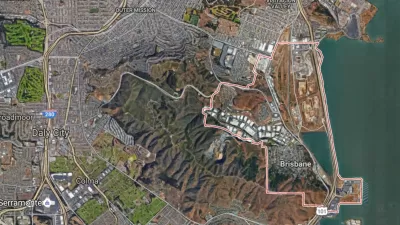Emissions from electricity generation are decreasing while those from transportation are increasing. If communities don't increase housing density to change travel patterns, it will only get worse, but the challenges may be insurmountable.

"While emissions from electrical plants fell in 2015, driven down partly by the rapid growth of large solar facilities, the amount of greenhouse gases spewed by cars and planes rose," reported David R. Baker for the San Francisco Chronicle in June on the California Greenhouse Gas Emission Inventory - 2017 Edition.
Illustrating why it is so difficult to reduce those transportation emissions, Liam Dillon reported for the Los Angeles Times on March 6 on the necessity to reduce driving in Southern California to meet climate goals, and the resistance by local communities to making the necessary land use changes that will change travel patterns.
“You can’t be pro-environment and anti-housing,” said Marlon Boarnet, chair of the Department of Urban Planning and Spatial Analysis at USC’s Price School of Public Policy, who has advised state climate regulators on land-use issues. “You can’t be anti-sprawl and anti-housing. This is something that has not been very well understood.”
The Southern California Association of Governments (SCAG), the metropolitan planning organization (MPO) for Los Angeles, Imperial, Orange, Riverside, San Bernardino and Ventura counties, has to prepare a regional transportation plan and sustainable communities strategy that shows how it will reduce greenhouse gas emissions resulting from transportation, as do the state's other 17 MPOs, according to SB 375, the Sustainable Communities and Climate Protection Act of 2008.
But those efforts haven’t been enough. In a series of reports over the last year, climate regulators have said California needed to reduce driving by an additional 15% over what regional governments have already planned to meet the 2030 greenhouse gas targets. That means even more closely packed housing than previously anticipated will be needed.
Hasan Ikhrata, SCAG's executive director, believes the new push to reduce driving is too difficult to achieve. “We’re going to do our best, but I think it’s too ambitious, to be honest with you,” Ikhrata said.
Of course, resistance to increased density is not restricted to Southern California. Reporting on July 28 from the small Bay Area city of Brisbane, population 4,700, just south of San Francisco in San Mateo County, Dillon describes the opposition to a development proposal located adjacent to a commuter rail station that could create a substantial dent in the region's housing crisis by providing 4,400 homes on 660 acres of vacant brownfield. But it's more than just local opposition to increased density that makes smart growth difficult in the Golden State.
The project, Brisbane Baylands, reveals how few incentives local governments have to accept large developments — even as the state is pushing to lower housing costs and funnel growth toward existing cities and nearby mass transit to combat climate change.
Under California’s tax system, Brisbane also earns more money if it rejects the current plan in favor of potential alternatives with more hotel rooms and space for businesses — but no homes.
While the "anti-development fervor" that has gripped Brisbane is the main focus of Dillon's piece, he also describes the challenges posed by the regulatory and economic framework that make smart growth so challenging in the state's coastal regions.
Hat tip to David McCoard.
FULL STORY: A Bay Area developer wants to build 4,400 sorely needed homes. Here's why it won't happen

Maui's Vacation Rental Debate Turns Ugly
Verbal attacks, misinformation campaigns and fistfights plague a high-stakes debate to convert thousands of vacation rentals into long-term housing.

Planetizen Federal Action Tracker
A weekly monitor of how Trump’s orders and actions are impacting planners and planning in America.

San Francisco Suspends Traffic Calming Amidst Record Deaths
Citing “a challenging fiscal landscape,” the city will cease the program on the heels of 42 traffic deaths, including 24 pedestrians.

Defunct Pittsburgh Power Plant to Become Residential Tower
A decommissioned steam heat plant will be redeveloped into almost 100 affordable housing units.

Trump Prompts Restructuring of Transportation Research Board in “Unprecedented Overreach”
The TRB has eliminated more than half of its committees including those focused on climate, equity, and cities.

Amtrak Rolls Out New Orleans to Alabama “Mardi Gras” Train
The new service will operate morning and evening departures between Mobile and New Orleans.
Urban Design for Planners 1: Software Tools
This six-course series explores essential urban design concepts using open source software and equips planners with the tools they need to participate fully in the urban design process.
Planning for Universal Design
Learn the tools for implementing Universal Design in planning regulations.
Heyer Gruel & Associates PA
JM Goldson LLC
Custer County Colorado
City of Camden Redevelopment Agency
City of Astoria
Transportation Research & Education Center (TREC) at Portland State University
Jefferson Parish Government
Camden Redevelopment Agency
City of Claremont





























